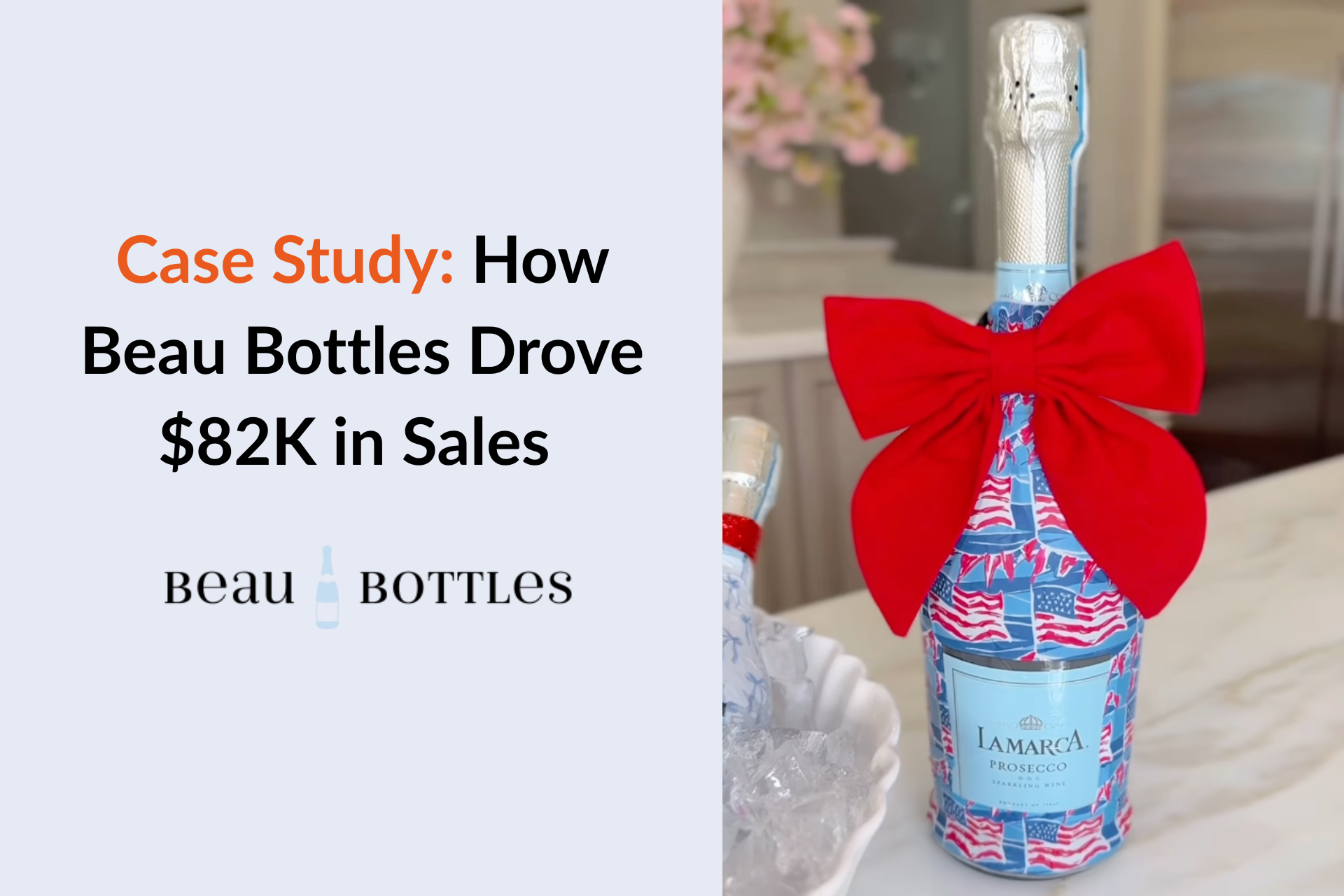





Influencer Impact provides small to mid-sized brands and agencies with AI-powered influencer discovery, modular reporting, campaign management, and audience insights across TikTok, Instagram, and YouTube. While it is accessible and intuitive, some teams may find its influencer database limited, automation capabilities basic, or retail-focused content tools absent for more advanced campaigns.
Among the alternatives, Influencer Hero emerges as a standout replacement for Influencer Impact, offering AI-driven influencer discovery, automated campaign workflows, built-in CRM, affiliate tracking, gifting, and UGC management—all within a single intuitive platform. Its extensive multi-platform coverage, real-time analytics, and 24/7 support make it particularly suitable for DTC and eCommerce brands that need scalable, measurable campaign execution.
This guide reviews the leading Influencer Impact alternatives, providing detailed comparisons of features, usability, and pricing. The insights here help you select the platform that best fits your team’s size, marketing budget, campaign complexity, and growth objectives in 2025.
Top 10 Influencer Impact Alternatives
1.Influencer Hero
2. Modash
3. Upfluence
4. Captiv8
5. CreatorIQ
6. HypeAuditor
7. GRIN
8. gen.video
9. Vyrill
10.Loox
While Influencer Impact offers AI-powered discovery, detailed audience insights, and automated campaign reporting, it may not fully meet the needs of every brand or agency. The lack of public reviews, limited support visibility, and pricing that scales steeply with influencer partnerships are potential drawbacks that can lead some teams to consider other platforms.
Unlike many competitors, Influencer Impact does not have published customer testimonials or independent reviews. This lack of external validation can make it difficult for brands to gauge trust, reliability, and real-world performance before committing.
The entry-level £200/month plan is accessible for smaller campaigns, but costs rise quickly as partnerships scale. Brands managing 100–300 influencers may face monthly fees of £400–£1,200, which can become restrictive compared to platforms with more flexible or usage-based pricing.
The platform provides demos and internal resources, but direct live support availability is not clearly advertised. For agencies running high-volume campaigns, this lack of transparency in customer support may hinder quick issue resolution.
While the platform is intuitive for basic influencer searches and campaign setup, more advanced functions like modular reporting and lookalike discovery can require extra training. This may slow down adoption for lean teams without dedicated specialists.
To compare the different platforms, we focused on central criteria that all must meet:

Platform Coverage: Influencer Impact provides brands and agencies with tools to discover, validate, and manage influencers across TikTok, Instagram (including Stories), and YouTube.
Best For: Small to mid-sized brands and agencies looking to streamline influencer discovery and campaign execution with AI-powered tools, detailed reporting, and collaboration features.
Pricing: Influencer Impact offers tiered plans based on influencer partnerships. The basic plan, Impact101, starts at £200/month for up to 50 influencer partnerships. Partnerships with 100 influencers start at £400/month, while the top tier allows up to 300 partnerships at £1,200/month.
Review: No public reviews from brands or customers are available, which may reduce external credibility.
Ease of Use (UX/UI): Users benefit from an intuitive dashboard that allows AI-powered influencer discovery, automated data collection, and modular reporting. The learning curve is low for basic campaigns, but advanced reporting and segmentation may take some practice.
Customer Support: Support is available via demo booking and internal platform guides. Direct live support availability is not clearly advertised.
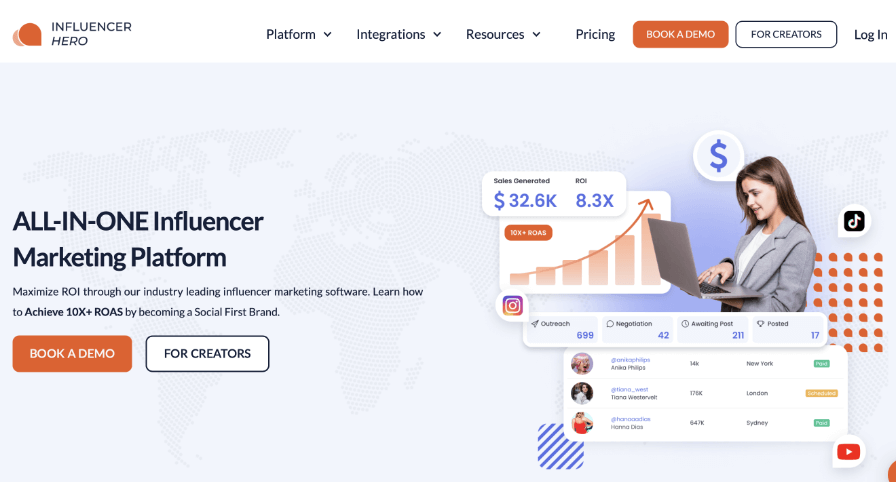
Platform Coverage: Influencer Hero supports influencer marketing across Instagram, TikTok, YouTube, Facebook, Pinterest, Snapchat, X (Twitter), and Twitch.
Best For: Influencer Hero is best for fast-scaling DTC brands and eCommerce businesses on Shopify, WooCommerce, or custom setups looking to run high-volume influencer, affiliate, and UGC campaigns from a single dashboard.
Pricing: Influencer Hero offers flexible monthly plans:
Reviews: 5.0 / 5.0 on Capterra
Ease of Use (UX/UI): Campaign flows are visually structured, with ready-made templates that guide even new users through setup and execution. Advanced teams benefit from granular workflow control without losing overall simplicity.
Customer Support: Every client receives personalized help, including account managers at all tiers and Slack communication for Pro and Business. Support operates 24/7 across chat, email, and an extensive knowledge base.
Influencer Hero’s plans start at $649/month for up to 1,000 creators, scaling to $2,490/month for 10,000 creators, whereas Influencer Impact begins at £200/month for up to 50 influencer partnerships and goes up to £1,200/month for 300 partnerships. The pricing structure alone makes Influencer Hero a better fit for brands that need high-volume campaigns with predictable scalability.
Influencer Hero provides advanced AI-driven discovery, workflow automation, centralized messaging, and commerce-linked tracking in one platform, giving teams full control of influencer, affiliate, and UGC programs. Influencer Impact also offers AI discovery and reporting but lacks integrated communication, affiliate management, and publicly available case studies, limiting its operational scope.
Support and usability further separate the two platforms: Influencer Hero includes 24/7 support, Slack communication, and personalized account managers at all tiers. While Influencer Impact has intuitive dashboards, customer support visibility is limited, and advanced reporting requires additional training, making Influencer Hero the more robust, all-in-one solution for scaling brands.
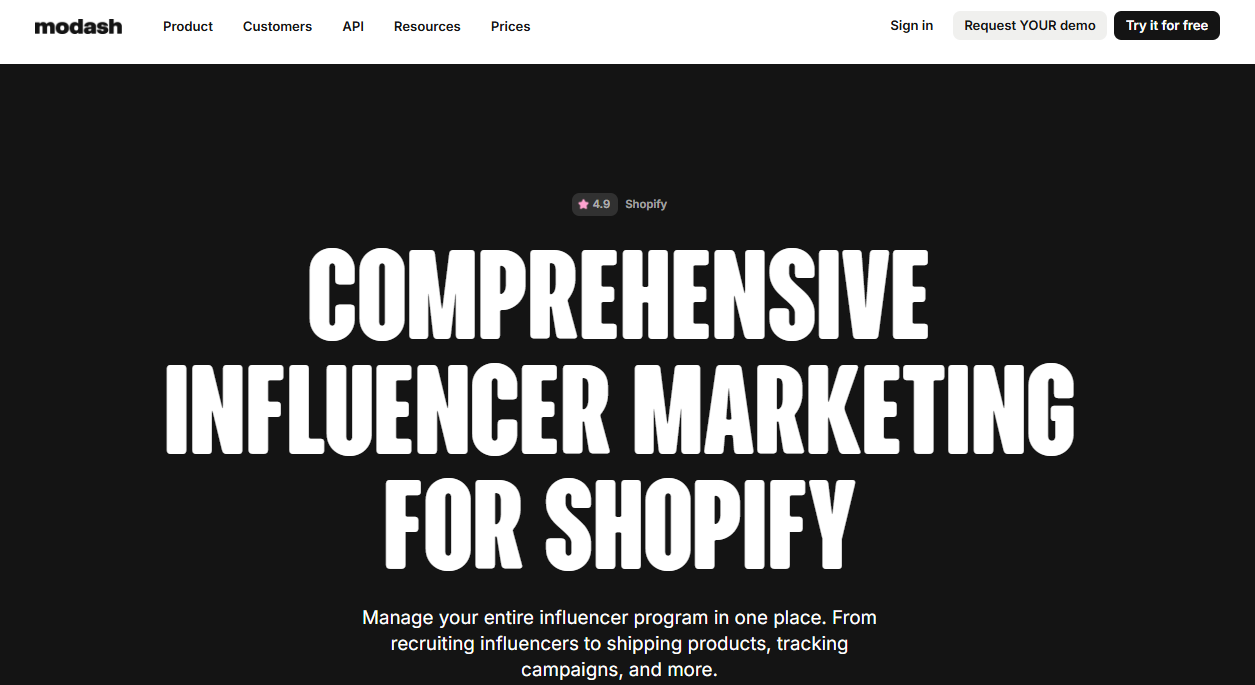
Platform coverage: Instagram, YouTube and TikTok. Limited functionality for influencers from Snapchat and X.
Pricing: Modash pricing starts at $199 per month. They also offer a medium tier plan fixed at a $499 rate. The enterprise level plan has custom pricing.
Reviews: 4.9/5.0 (Capterra)
Ease of Use (UX/UI): Modash offers a streamlined layout built for quick influencer discovery. Filters respond instantly, making campaign setup smooth with minimal onboarding.
Customer Support: All customers get email support, while premium tiers include live chat and priority responses. Tutorials and a detailed help center simplify the learning process.
Modash starts at $199/month, with a medium tier at $499/month and enterprise pricing customized, whereas Influencer Impact’s plans start at £200/month for 50 influencers, scaling to £1,200/month for 300 partnerships. Brands choosing Modash have transparent pricing for mid-tier options, whereas Influencer Impact’s cost grows quickly with additional influencer slots.
Modash offers a wide creator database covering Instagram, TikTok, and YouTube, including fake follower detection and lookalike audience suggestions. Influencer Impact similarly provides AI-powered influencer discovery and fake follower detection, but includes modular reporting dashboards and internal collaboration tools as a differentiator.
Both platforms deliver performance tracking and automated campaign monitoring, though Modash’s API access and exportable campaign reports are especially suited for large-scale programs. Influencer Impact focuses on small to mid-sized brands, emphasizing integrated communication and streamlined group management for multiple campaigns.

Platform coverage: Upfluence covers Instagram, TikTok, YouTube, X, Twitch, Pinterest, and WordPress blogs.
Pricing:
Reviews: 4.6/5.0 (G2)
Best For: E-commerce brands and agencies looking to scale YouTube influencer outreach and track ROI.
Ease of Use (UX/UI): Designed for large-scale influencer marketing, the platform has a comprehensive dashboard that requires some learning but allows full workflow management once familiar. Teams benefit from a highly structured environment that keeps campaign execution organized.
Customer Support: Upfluence offers onboarding sessions and dedicated account managers for higher tiers. Email and live chat support ensure marketers have guidance to ramp up campaigns efficiently.
Upfluence’s Standard Plan costs $1,276/month with an annual term or $399/month for gifting-only campaigns, compared with Influencer Impact’s £200–£1,200/month tiers based on influencer count. The pricing difference reflects Upfluence’s focus on large-scale e-commerce campaigns, while Influencer Impact targets smaller and mid-sized teams.
Upfluence supports multiple platforms including Instagram, TikTok, YouTube, X, Twitch, Pinterest, and WordPress blogs, offering affiliate tracking and CRM integration. Influencer Impact covers Instagram, TikTok, and YouTube, focusing on AI-powered influencer discovery and detailed audience insights rather than multi-channel affiliate workflows.
Campaign execution is centralized in Upfluence with automated payments, content tracking, and workflow tools, whereas Influencer Impact emphasizes modular reporting and in-platform collaboration. Both platforms provide real-time monitoring, but Upfluence caters to larger, enterprise-scale campaign management.
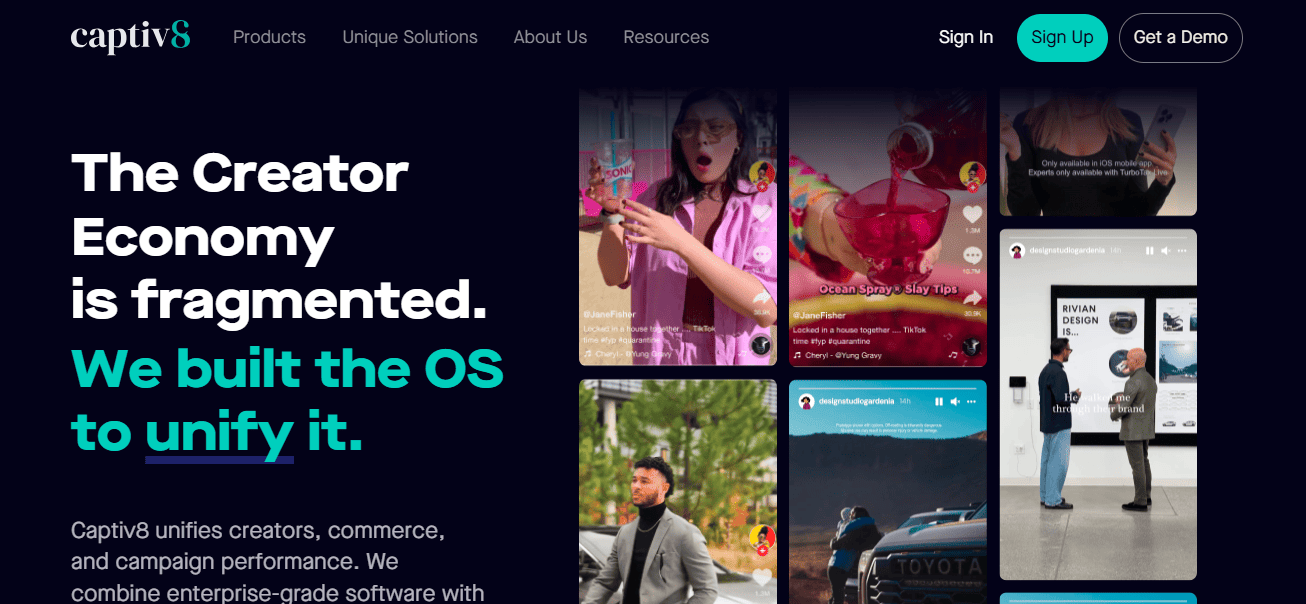
Platform coverage: Captiv8 covers Instagram, TikTok, Facebook, YouTube, X (formerly Twitter) and Twitch.
Pricing: $25.000 Annually (Annual commitment needed). Plus a $3.000 onboarding fee.
Reviews: 4.5/5.0 (G2)
Best for: Brands and agencies running large-scale influencer campaigns in platforms like Instagram, TikTok and YouTube.
Ease of Use (UX/UI): Captiv8 provides advanced tools tailored for experienced marketers, but first-time users may need extra time to navigate the platform. Its design supports large-scale campaigns with detailed analytics and multi-team collaboration.
Customer Support: Offers dedicated onboarding, campaign guidance, and account managers. Some users report slower response times for urgent billing or technical queries.
Captiv8 pricing starts at $25,000 annually, with a $3,000 onboarding fee, while Influencer Impact begins at £200/month for 50 influencers. This highlights Captiv8’s enterprise-level focus compared with Influencer Impact’s small to mid-market accessibility.
Captiv8 offers AI-powered influencer matching, paid media amplification, and competitive benchmarking, making it ideal for experienced marketing teams running large-scale campaigns. Influencer Impact also includes AI discovery and competitor insights but emphasizes modular reporting dashboards and internal campaign communication.
Both platforms provide campaign ROI tracking and fraud detection, though Captiv8’s setup is more complex and tailored for enterprise teams. Influencer Impact prioritizes user-friendly dashboards, streamlined communication, and real-time reporting for smaller teams without enterprise onboarding requirements.
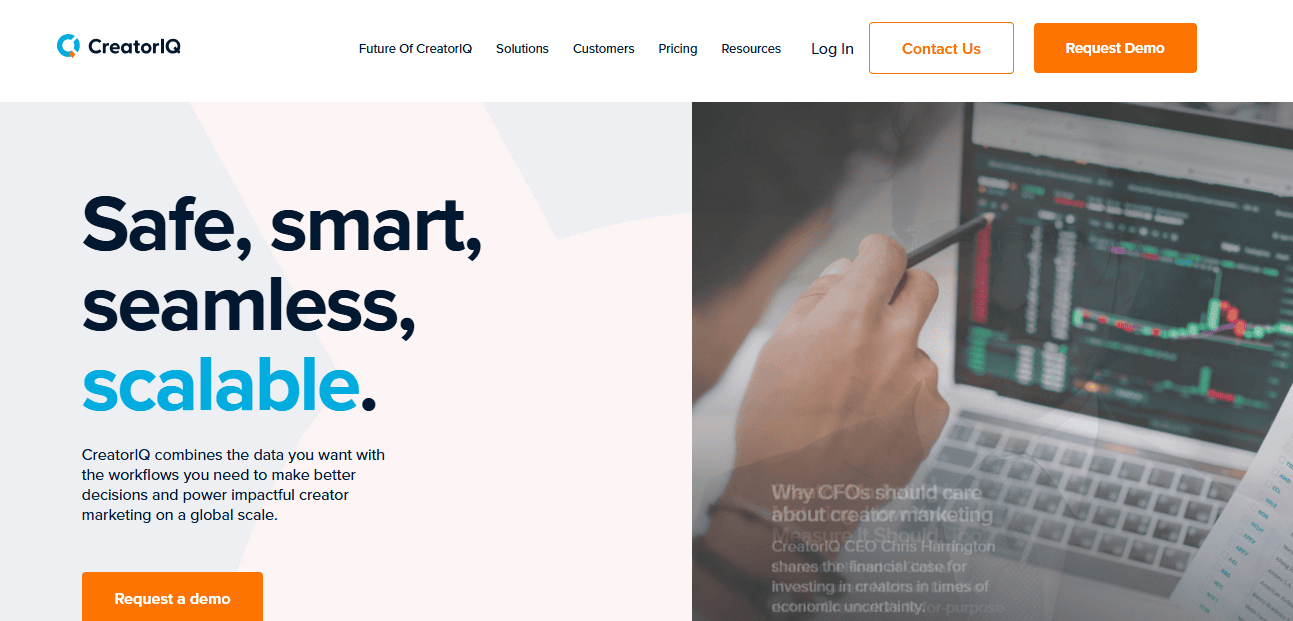
Platform Coverage: CreatorIQ supports Instagram, TikTok, YouTube, Facebook, Pinterest, Twitch, and X (Twitter).
Pricing: CreatorIQ pricing is divided into 4 tiers:
An optional “Creator Connect” feature available for an additional $15,000 per yea
Reviews: 4.6/5.0 (G2)
Best For: Large-scale brands that require robust data controls, customizable workflows, and in-depth influencer analytics across international markets.
Ease of Use (UX/UI): CreatorIQ provides a polished interface aimed at enterprise teams handling multiple influencer programs simultaneously. Its workflow tools and automation options help reduce repetitive setup, though navigating the vast feature set requires practice.
Customer Support: Each client receives a dedicated account manager and ongoing strategy consultations. Global teams benefit from support that ensures campaigns consistently achieve performance targets.
CreatorIQ pricing begins at $35,000/year for the Basic plan and scales up to $200,000/year for Enterprise, significantly higher than Influencer Impact’s £200–£1,200/month tiers. This reflects CreatorIQ’s focus on large-scale enterprise clients managing thousands of influencers across multiple global markets.
CreatorIQ offers an enterprise-grade database, CRM, workflow automation, and data enrichment that allow complex multi-market campaigns with detailed compliance and reporting. Influencer Impact provides AI-powered discovery and reporting for smaller teams but lacks CreatorIQ’s depth in workflow automation and global influencer management.
Support for CreatorIQ includes dedicated account managers and strategy consultations for enterprise clients, whereas Influencer Impact has limited visibility into live support options. Brands needing advanced analytics, compliance, and multi-market scalability may find CreatorIQ a more suitable but pricier option.
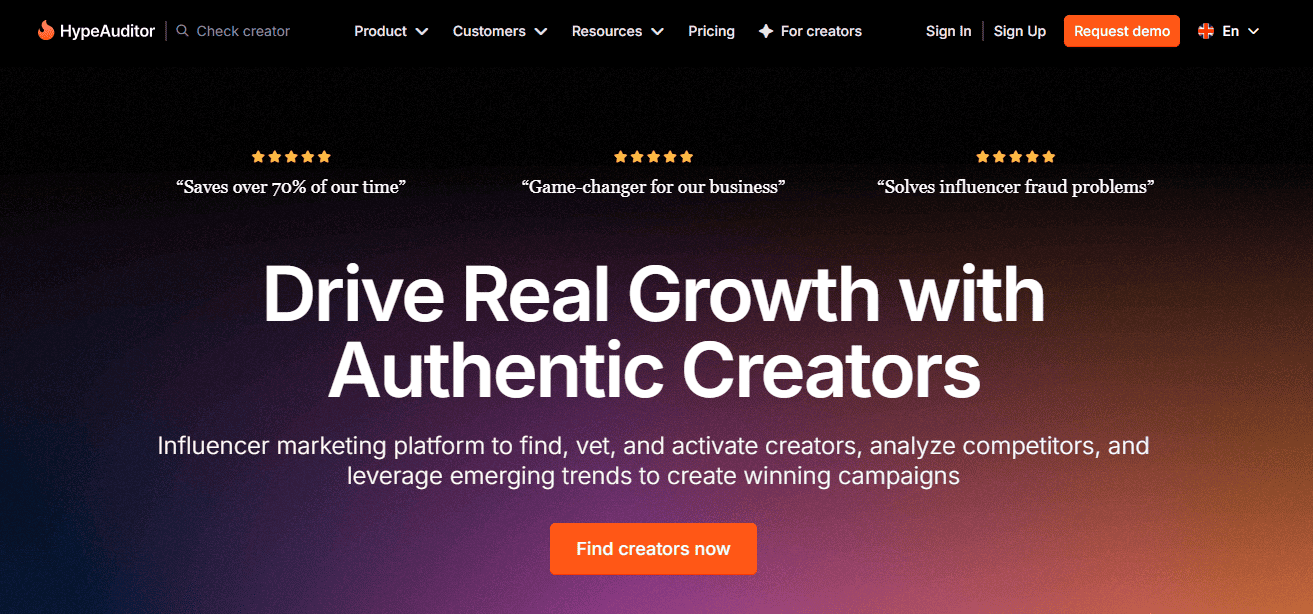
Platform Coverage: HypeAuditor supports Instagram, TikTok, YouTube, Twitch, X (Twitter), and Snapchat.
Pricing: Flexible usage-based pricing, with Business plans starting at around $10,000/year and Enterprise reaching up to $60,000/year.
Reviews: 4.6/5.0 (G2)
Best For: Teams that prioritize data accuracy, detecting fraudulent activity, and benchmarking competitors across various influencer platforms.
Ease of Use (UX/UI): HypeAuditor offers a sleek, analytics-focused interface designed for performance insights. Some tools require practice to unlock the full potential of the platform’s advanced metrics.
Customer Support: Teams can access onboarding support, live chat, and email assistance alongside an extensive knowledge base. This ensures campaigns are activated efficiently and data questions are resolved quickly.
HypeAuditor’s Business plan starts around $10,000/year, with Enterprise reaching $60,000/year, which is considerably higher than Influencer Impact’s entry-level pricing of £200/month. This positions HypeAuditor as a premium analytics and fraud detection tool rather than a full influencer management system.
HypeAuditor specializes in AI-driven fraud detection, deep audience insights, competitive benchmarking, and real-time campaign metrics. Influencer Impact offers similar AI-powered discovery and fake follower detection but lacks HypeAuditor’s advanced research-oriented analytics and large-scale competitor monitoring.
While HypeAuditor provides onboarding support, live chat, and email assistance, its platform is highly research-focused and less suited for operational campaign management. Influencer Impact, in contrast, integrates campaign, communication, and reporting workflows into one interface for small and mid-sized brands.
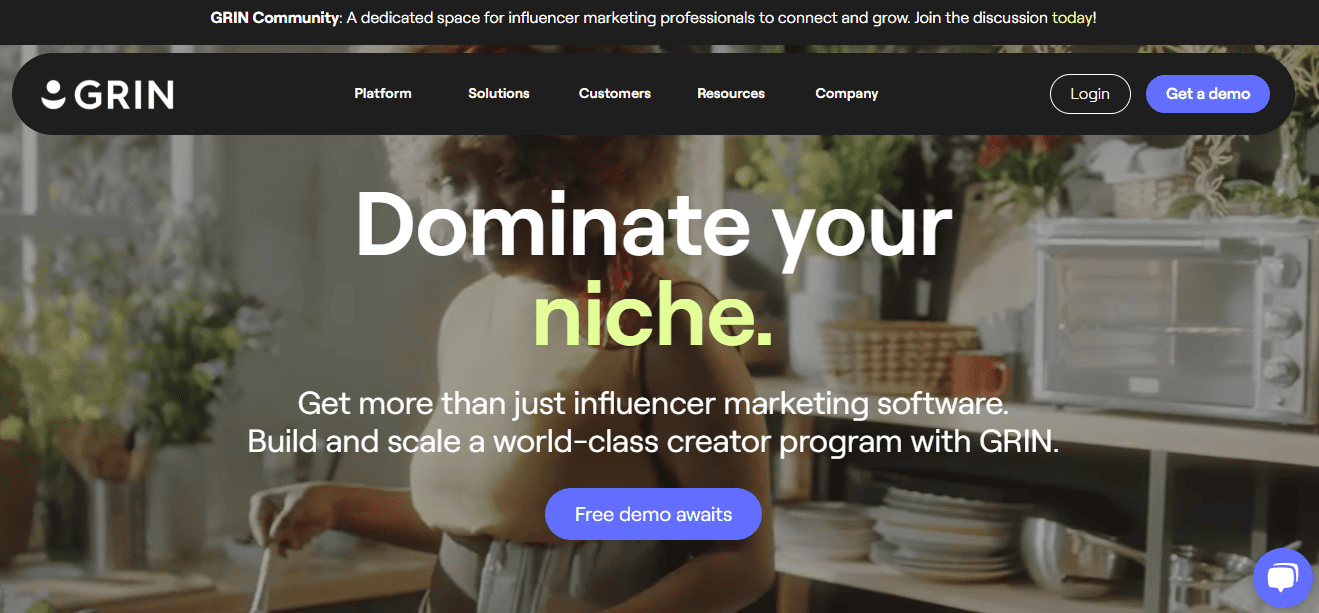
Platform Coverage: Instagram, TikTok, YouTube, X (formerly Twitter), Twitch, and Snapchat.
Pricing: GRIN’s yearly pricing starts at $25.000, with monthly payments available at $2.085/month. No discounts for upfront payments.
Best For: Best suited for DTC brands looking to centralize influencer relationship management in one streamlined system.
Reviews: 4.5/5.0 (G2)
Ease of Use (UX/UI): GRIN offers a smooth and intuitive interface for campaign basics. Larger influencer lists or batch operations can slow down the system.
Customer Support: Onboarding, chat, and email support are available for all tiers, with premium users receiving dedicated strategists. Support quality varies depending on subscription level.
GRIN starts at $2,085/month and $25,000/year, which is higher than Influencer Impact’s £200–£1,200/month range for small to mid-sized brands. GRIN is built for DTC brands needing centralized influencer relationship management with integrated affiliate and gifting workflows.
GRIN provides advanced influencer discovery, campaign guidance, revenue-linked CRM, and automated workflows to streamline influencer, affiliate, and content management. Influencer Impact also has AI-powered discovery and reporting, but it does not include GRIN’s full suite of revenue tracking and enterprise-level campaign automation tools.
Customer support on GRIN includes onboarding, chat, email, and premium users get strategists, whereas Influencer Impact relies mostly on internal guides and demo bookings. Brands seeking full-scale influencer program automation may prefer GRIN despite higher costs, while smaller teams may benefit from Influencer Impact’s accessibility and lower entry price.
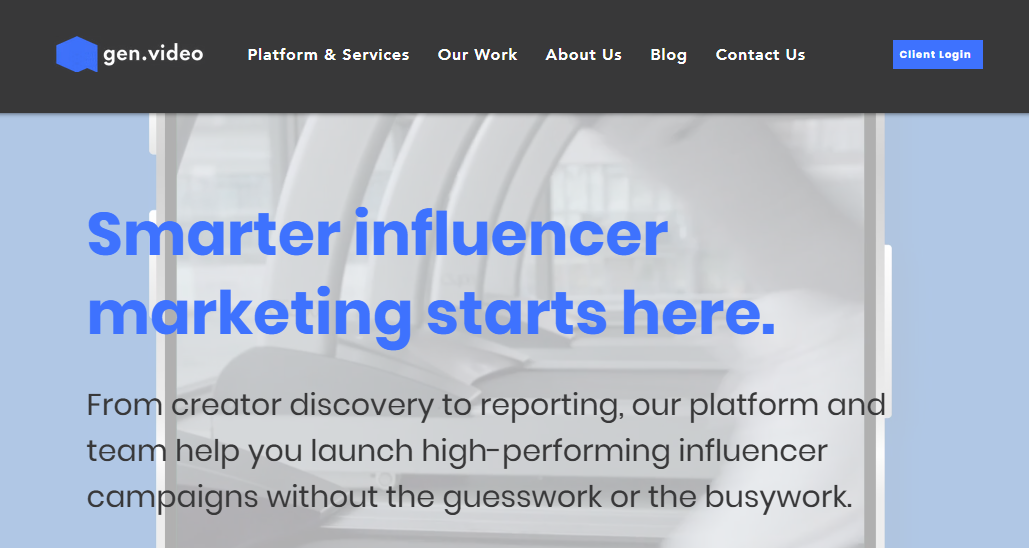
Platform Coverage: Instagram, TikTok, YouTube
Pricing: Custom enterprise-based pricing depending on campaign scope, features, and retailer integrations
Reviews: 4.7/5.0 (G2)
Best For: Brands and agencies selling through major retailers that want video-first creator programs with shoppable content and retail sales attribution (e.g., Amazon, Walmart, Target).
Ease of Use (UX/UI): Clean and modern UI with collaboration features like timestamped video feedback. Some workflows can feel cumbersome until teams adapt to the system.
Customer Support: Responsive onboarding and client success teams; praised for fast replies and hands-on guidance across creator sourcing, approvals, and reporting.
gen.video pricing is custom/enterprise-based and not publicly listed, while Influencer Impact offers defined tiers starting at £200/month. gen.video is designed for brands selling through major retailers, focusing on shoppable video content and measurable ROI across social and digital retail.
Its standout features include shoppable retail integrations, content syndication, advanced measurement, creator CRM, UGC sourcing at scale, retail media support, and immersive shopping pages. Influencer Impact provides AI-powered discovery, audience insights, and campaign management but lacks the retail-first video commerce integrations that gen.video offers.
Customer support for gen.video is highly praised for onboarding and campaign guidance, but workflows can feel clunky until learned. Influencer Impact’s intuitive dashboards and modular reporting make it more immediately usable for small to mid-sized brands not heavily focused on retail video commerce.

Platform Coverage: YouTube, Instagram, TikTok, and other video-focused social platforms
Pricing:
Reviews: 4.0/5.0 (G2)
Best For: D2C brands and retailers looking to increase trust and conversions through video commerce.
Ease of Use (UX/UI): Integrates seamlessly with ecommerce and Shopify; AI-powered in-video search is powerful but may take time to master for advanced filtering.
Customer Support: Email and live chat for Starter and Growth; Enterprise includes phone support and custom onboarding.
Vyrill’s Starter plan begins at $249/month and scales to $499/month for Growth, with Enterprise custom pricing, placing it above Influencer Impact’s lower-tier plans but below high-end enterprise platforms. Vyrill targets D2C brands and retailers emphasizing video commerce, UGC licensing, and personalized product video carousels.
The platform provides AI-powered in-video search, video discovery and licensing, fan and expert identification, video commerce carousels, competitor intelligence, campaign management, and an AI marketing agent. Influencer Impact offers AI discovery, fake follower detection, audience insights, and reporting, but it does not provide the same video-focused commerce capabilities or advanced UGC repurposing features.
Vyrill offers email, live chat, and phone support depending on the plan, but some users note a learning curve with advanced analytics. Influencer Impact’s all-in-one influencer campaign management system is easier for small to mid-sized brands looking to run multi-platform campaigns without specialized video commerce features.

Platform Coverage: Shopify stores with integrations for Google Shopping, Meta Shops, Klaviyo, Omnisend, Shopify Plus
Pricing:
Reviews: 4.9/5.0 (G2)
Best For: Shopify merchants of all sizes looking to showcase photo and video reviews, drive trust with UGC, and boost referrals and upsells.
Ease of Use (UX/UI): Easy setup, no coding needed, widgets integrate well with product pages. Some report mobile lag and limited font/color customization.
Customer Support: 24/7 email support; mixed reviews with some delays or unhelpful responses.
Loox pricing ranges from $12.99/month for basic plans to $299.99/month for unlimited features, which is significantly more accessible than Influencer Impact’s £200–£1,200/month range for multi-platform campaigns. Loox is designed primarily for Shopify merchants to collect and display photo and video product reviews, automate review requests, and run referral and upsell campaigns.
Its standout features include photo/video reviews, automated review emails, referral programs, upsell via reviews, customizable widgets, integrations with Shopify Plus and marketing tools, and mobile-optimized displays. Influencer Impact focuses on influencer discovery, audience validation, campaign management, and reporting across multiple social platforms rather than UGC product reviews for ecommerce.
Support for Loox is email-based, with mixed reviews on responsiveness, while Influencer Impact offers platform guidance through demos and internal resources. Brands seeking social influencer campaigns across TikTok, Instagram, and YouTube will find Influencer Impact better suited for multi-platform influencer strategy, whereas Loox is more niche to Shopify review management.
If you’re looking for a platform to manage influencer campaigns with AI-driven discovery, audience insights, and modular reporting, Influencer Impact offers a solid starting point for small to mid-sized brands. However, some teams may need larger influencer databases, advanced automation, enterprise-grade workflows, or retail-focused video content to meet more complex campaign needs.
Among these alternatives, Influencer Hero stands out for brands focused on DTC and eCommerce campaigns—providing AI-powered influencer discovery, CRM, automated workflows, affiliate tracking, gifting, and UGC management all in one intuitive dashboard. Its combination of multi-platform reach, workflow-driven outreach, and 24/7 support allows teams to scale efficiently while keeping campaign performance measurable in real time.

Top alternatives include Influencer Hero, Modash, Upfluence, Captiv8, CreatorIQ, HypeAuditor, GRIN, gen.video, Vyrill, and Loox. Among these, Influencer Hero provides the most complete all-in-one solution with influencer discovery, CRM, UGC management, affiliate tracking, and detailed performance analytics.
Influencer Impact is strong for AI-powered discovery, audience insights, and modular reporting, but brands seeking larger influencer pools, advanced automation, or specialized video commerce tools may prefer other options. Platforms like Upfluence and Modash provide broader creator networks and detailed analytics, while CreatorIQ and GRIN cater to enterprise-level management.
For DTC and eCommerce campaigns, Influencer Hero is a top choice with Shopify and WooCommerce integrations, streamlined gifting, affiliate tracking, and UGC management. GRIN also provides strong eCommerce workflows with revenue-linked CRM, and gen.video or Vyrill may appeal to brands emphasizing retail video content.
Influencer Impact offers tiered plans from £200/month up to £1,200/month depending on the number of influencer partnerships. In contrast, Influencer Hero starts at $649/month, Upfluence and Captiv8 are premium solutions for larger teams, GRIN begins around $25,000/year, and platforms like HypeAuditor and CreatorIQ target enterprise budgets starting at $10,000/year and $35,000/year respectively.
For an all-in-one approach, Influencer Hero combines AI discovery, campaign management, workflow automation, UGC collection, affiliate tracking, and analytics within a single platform. While other platforms excel in specialized areas—like Modash for influencer vetting, HypeAuditor for fraud detection, or Loox for product review UGC—Influencer Hero delivers the broadest toolkit for small to mid-sized DTC and eCommerce brands.



Schedule a Demo with one of our media experts below.